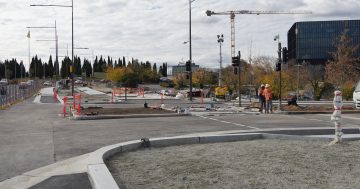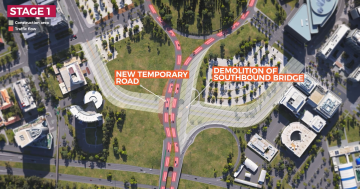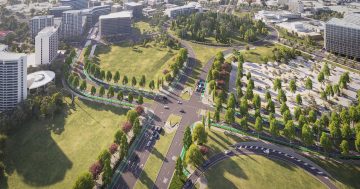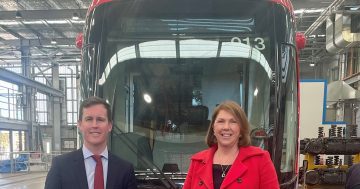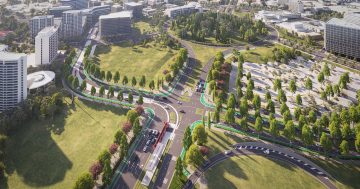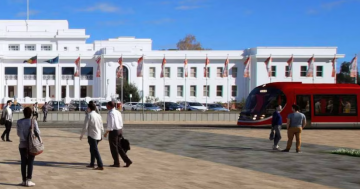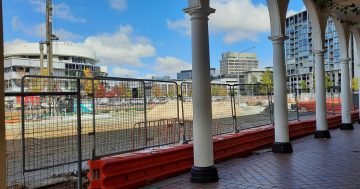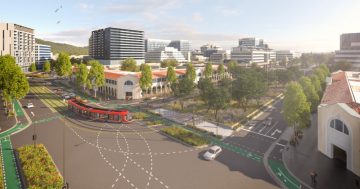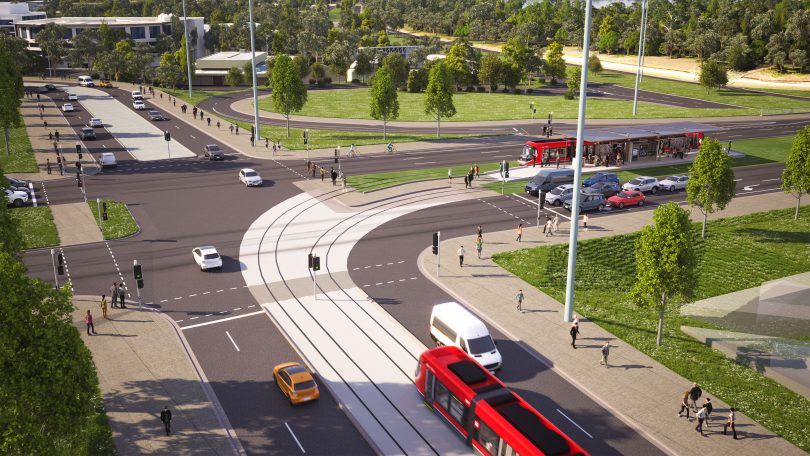
An artist’s impression of the intersection of London Circuit and Commonwealth Avenue on the light rail Stage 2A route to Commonwealth Park. Image: ACT Government.
The raising of London Circuit and the loss of the clover leaf southern gateway to Civic will increase travel times, result in reduced urban amenity and facilitate an inferior public transport option, according to a submission to the National Capital Authority consultation on the ACT Government proposal.
The Inner South Canberra Community Council questions most of the proposal’s assumptions and says it is part of a piecemeal approach to the light rail to Woden project.
Its says that if it is to facilitate the light rail stage 2A to Commonwealth Park, then it should be considered in light of the entire Stage 2 project, including across the lake to Woden.
“It is our view that light rail Stage 2A cannot be justified on its own, and statements by the Government (and the Auditor-General) appear to support that view,” the submission says.
“Stage 2A can only be justified if Stage 2B is approved. In the absence of Stage 2B, Stage 2A would be a ‘white elephant’.”
The council says the NCA should delay consideration of the proposal until documentation is available for all of Stage 2.
It says the Auditor-General has found that light rail 2A has very low benefit cost ratio and its calculation, presented in the business case, is dubious, and when the additional cost of raising London Circuit is taken into account ($9 million in 2021-22), the benefit cost ratio is even lower .
“In the light of the Auditor-General’s findings alone, the project cannot be justified and should not be approved,” the submission says.
It says the NCA should not consider any part of the light rail project until the Government has responded to the Auditor-General’s report.
The council also says the works application makes a number of unsubstantiated claims about how the project is in line with the National Capital Plan vision, will align the road network with strategic transport and land use planning for the city and improve urban amenity and support the revitalisation of the city precinct.
It says these are just part of the Government’s marketing for the project.
“In our view, removing grade separation between London Circuit and Commonwealth Avenue will significantly reduce urban amenity and impede traffic flows between north and south Canberra,” it says.
“It is very difficult to see how the proposed new intersection with traffic lights will result in improved urban design. What it will do is to impede traffic flow between north and south Canberra.”
Claims that the light rail will future-proof the transport network should be rejected, the council says, pointing to inflexible routes, inability to provide express services, and high track construction costs with significant greenhouse gas emissions.
The council is also concerned that raising London Circuit will have a negative impact on the landscape and vistas that are an essential element of the Griffin design.
It criticises the NCA for its limited scope, saying it to should be taking a much deeper look at the rationale for the project than just the design, quality and traffic modelling.
“This project involves a large investment and would have significant adverse impacts in both the construction and operational phases,” the council says.
“All aspects of the project should therefore be thoroughly examined by the NCA to ensure that the NCA’s legislative responsibility for ensuring Canberra is planned and designed in accordance with its national significance is properly discharged.”












